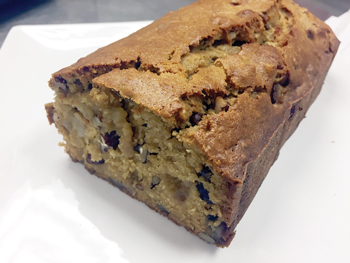
Vol. 17 No. 11 - December 28, 2016
FEATURE
Preserving our produce

submitted
Fig and walnut bread is a great holiday treat.
Once upon a time, families weren’t accustomed to advancements in modern farming and product delivery technology. Our current food system allows us to have lettuces hydroponically grown in California, heirloom indeterminate striped Roma tomatoes from Canada, fish from the Gulf caught using a hand thrown seine locally made by a mermaid tribe in Cortez, and zephyr squash from Florida grown by a sixth generation organic specialist - all delivered to your door in Tennessee, still fresh and ready to eat. While we could sit back and marvel at our accomplishments, we should be trying to figure out what went wrong.
To be fair, maybe nothing went wrong, but instead maybe we all took a lot for granted. We expect to have that perfect tomato on our hamburger, and we expect that the lettuce will be crisp and bright all year round. In this day and age, it is, and it can. And because of our innovations, we have figured out how to move these items across massive distances in very little time, consistently and while preserving nearly all of that items’ freshness and flavor.
Sure, picking a ripe peach off of the tree will always be better than having one shipped more than 1,000 miles, even if it is delivered just the next day. The thing is, back in the day, but not too long ago, we used to go out and find food that grew near us. We used to bring it home and have one of our relatives, who remembered recipes passed down from their previous generations, do something with it. For me, it was my great grandmother’s blackberry cobbler.
When I was no more than 5, I remember going to her house in southern Alabama and walking for what seemed like miles to find the blackberry bushes. We’d fill up milk jugs full of blackberries to bring back to the house for her to “play” with. Without fail, we had the world’s best blackberry cobbler waiting for us for dessert.
As a society, we used to know our butcher, and we used to know our farmer; I imagine what those days must have been like and can only assume that something like it still exists in countries that haven’t yet experienced an explosion in monoculture.
Something happened between when we were kids and now, where we have forgotten the best part of food. It’s being able to taste that peach at the height of its freshness for more than the three weeks that they are ripe in Florida. It’s being able to preserve them and save them for months to come.
I brought a human resources coordinator, who is responsible for helping us find our international interns interested in learning U.S. restaurant culture, to the Chiles Group farm in Parrish. She was amazed and excited to see the possibilities. While it all looks wonderful, from time to time, the farm produces much more than our restaurants can handle, which without proper outlets established to sell all of the viable produce, would end up simply as fertilizer.
I explained that we have made jam with our excess tomatoes, have pickled peaches from King’s Family Farm, have made blueberry compote from the berries we got from the Chiles’ family farm, Jubilee Farms, in Tallahassee, and have pickled pears from Jubilee as well. This process allows us to extend the life of produce that would otherwise have gone bad and been wasted.
Excited to hear about preservation, she told me stories of her childhood where she would forage for coveted mushrooms, indigenous to her region of Russia, which her grandmother would then pickle for the months to come. So many people have stories about a childhood full of watching a loved one care for the fruits of the land in ways that I hope we will continue to pass on to our little loved ones.
For those interested in preservation, I recommend taking a look at our menus periodically to see what is available seasonally. We have been rotating through peaches, blueberries, tomatoes and pears for the past two years and are constantly adding more to our repertoire!. As we all know, sugar, acids, such as vinegar and salt, are all preservatives. By utilizing these ancient techniques of preservation, we are able to savor these wonderful local products nearly year round.
Our current mission is to save hundreds of pounds of figs and papayas from one of our local farms. We are making pickled papaya to put on our salads, and making fig compote to put on our short rib, veggie sandwich, and maybe even our brunch waffles. You can get in the spirit of Christmas and make a holiday bread using figs or dates or any other local fruit you care to try.
Fig & Walnut Bread
Ingredients:
• 2 cups figs, chopped
• 4 Tbs, butter, softened
• 1 tsp. baking soda
• ¾ tsp. salt
• ¾ cup maple syrup
• 1 cup coffee
• 1 egg
• ½ vanilla bean
• 1 oz. brandy
• ½ tsp. baking powder
• 1 ¾ cup AP flour
• 1 cup walnuts
Directions:
Mix figs, butter, baking soda, salt, maple syrup and coffee. Stir to combine. Cool for 15 minutes. Add egg, vanilla, brandy, baking powder, flour and combine until smooth. Stir in walnuts. Place mixture in greased bread pan and bake at 350 for 45-55 minutes.

